PNR Metro Commuter Line
The PNR Metro Commuter Line is a commuter rail line operated by the Philippine National Railways. It was first inaugurated as the Metro Manila Commuter Service in 1970, and originally served the North Main Line and the South Main Lines, as well as the defunct Carmona and Guadalupe branch lines. Since then, it adopted several names such as Metrotrak[3] and Metrotren,[4] before adopting its present name in the late 2000s. The line is also nicknamed the Orange Line due to its designation in the 1970s.
| PNR Metro Commuter Line | ||||||||||||||||||||||||||||||||||||||||||||||||||||||||||||||||||||||||||||||||||||||||||||||||||||||||||||||||||||||||||||||||||||||||||||||||||||||||||||||||||||||||||||||||||||||||||||||||||||||||||||||||||||||||||||||||||||||||||||||||||||||||||||||||||||||||||||||||||||||||||||||||||||||||||||||||||||||||||||||||||||||||||||||||||||||||||||||||||||||||||||||||||||||||||||||||||||||||||||||||||||||||||||||||||||||||||||||||||||||||||||||||||||||||||||||||||||||||||||||||||||||||||||||||||||||||||||||||||||||||||||||||||||||||||||||||||||||||||||||||||||||||||||||||||||||||||||||||||||||||||||||||||
|---|---|---|---|---|---|---|---|---|---|---|---|---|---|---|---|---|---|---|---|---|---|---|---|---|---|---|---|---|---|---|---|---|---|---|---|---|---|---|---|---|---|---|---|---|---|---|---|---|---|---|---|---|---|---|---|---|---|---|---|---|---|---|---|---|---|---|---|---|---|---|---|---|---|---|---|---|---|---|---|---|---|---|---|---|---|---|---|---|---|---|---|---|---|---|---|---|---|---|---|---|---|---|---|---|---|---|---|---|---|---|---|---|---|---|---|---|---|---|---|---|---|---|---|---|---|---|---|---|---|---|---|---|---|---|---|---|---|---|---|---|---|---|---|---|---|---|---|---|---|---|---|---|---|---|---|---|---|---|---|---|---|---|---|---|---|---|---|---|---|---|---|---|---|---|---|---|---|---|---|---|---|---|---|---|---|---|---|---|---|---|---|---|---|---|---|---|---|---|---|---|---|---|---|---|---|---|---|---|---|---|---|---|---|---|---|---|---|---|---|---|---|---|---|---|---|---|---|---|---|---|---|---|---|---|---|---|---|---|---|---|---|---|---|---|---|---|---|---|---|---|---|---|---|---|---|---|---|---|---|---|---|---|---|---|---|---|---|---|---|---|---|---|---|---|---|---|---|---|---|---|---|---|---|---|---|---|---|---|---|---|---|---|---|---|---|---|---|---|---|---|---|---|---|---|---|---|---|---|---|---|---|---|---|---|---|---|---|---|---|---|---|---|---|---|---|---|---|---|---|---|---|---|---|---|---|---|---|---|---|---|---|---|---|---|---|---|---|---|---|---|---|---|---|---|---|---|---|---|---|---|---|---|---|---|---|---|---|---|---|---|---|---|---|---|---|---|---|---|---|---|---|---|---|---|---|---|---|---|---|---|---|---|---|---|---|---|---|---|---|---|---|---|---|---|---|---|---|---|---|---|---|---|---|---|---|---|---|---|---|---|---|---|---|---|---|---|---|---|---|---|---|---|---|---|---|---|---|---|---|---|---|---|---|---|---|---|---|---|---|---|---|---|---|---|---|---|---|---|---|---|---|---|---|---|---|---|---|---|---|---|---|---|---|---|---|---|---|---|---|---|---|---|---|---|---|---|---|---|---|---|---|---|---|---|---|---|---|---|---|---|---|---|---|---|---|---|---|---|---|---|---|---|---|---|---|---|---|---|---|---|---|---|---|---|---|---|---|---|---|---|---|---|---|---|---|---|---|---|---|---|---|---|---|---|---|---|---|---|---|---|---|---|---|---|---|---|---|---|---|---|---|---|---|---|---|---|---|---|---|---|---|---|---|---|---|---|---|---|---|---|---|---|---|---|---|---|---|---|---|---|---|---|---|---|---|---|---|---|---|---|---|---|---|---|---|---|---|---|---|---|
_wiki.jpg) | ||||||||||||||||||||||||||||||||||||||||||||||||||||||||||||||||||||||||||||||||||||||||||||||||||||||||||||||||||||||||||||||||||||||||||||||||||||||||||||||||||||||||||||||||||||||||||||||||||||||||||||||||||||||||||||||||||||||||||||||||||||||||||||||||||||||||||||||||||||||||||||||||||||||||||||||||||||||||||||||||||||||||||||||||||||||||||||||||||||||||||||||||||||||||||||||||||||||||||||||||||||||||||||||||||||||||||||||||||||||||||||||||||||||||||||||||||||||||||||||||||||||||||||||||||||||||||||||||||||||||||||||||||||||||||||||||||||||||||||||||||||||||||||||||||||||||||||||||||||||||||||||||||
| Overview | ||||||||||||||||||||||||||||||||||||||||||||||||||||||||||||||||||||||||||||||||||||||||||||||||||||||||||||||||||||||||||||||||||||||||||||||||||||||||||||||||||||||||||||||||||||||||||||||||||||||||||||||||||||||||||||||||||||||||||||||||||||||||||||||||||||||||||||||||||||||||||||||||||||||||||||||||||||||||||||||||||||||||||||||||||||||||||||||||||||||||||||||||||||||||||||||||||||||||||||||||||||||||||||||||||||||||||||||||||||||||||||||||||||||||||||||||||||||||||||||||||||||||||||||||||||||||||||||||||||||||||||||||||||||||||||||||||||||||||||||||||||||||||||||||||||||||||||||||||||||||||||||||||
| Type | Commuter rail | |||||||||||||||||||||||||||||||||||||||||||||||||||||||||||||||||||||||||||||||||||||||||||||||||||||||||||||||||||||||||||||||||||||||||||||||||||||||||||||||||||||||||||||||||||||||||||||||||||||||||||||||||||||||||||||||||||||||||||||||||||||||||||||||||||||||||||||||||||||||||||||||||||||||||||||||||||||||||||||||||||||||||||||||||||||||||||||||||||||||||||||||||||||||||||||||||||||||||||||||||||||||||||||||||||||||||||||||||||||||||||||||||||||||||||||||||||||||||||||||||||||||||||||||||||||||||||||||||||||||||||||||||||||||||||||||||||||||||||||||||||||||||||||||||||||||||||||||||||||||||||||||||
| Status | Operational | |||||||||||||||||||||||||||||||||||||||||||||||||||||||||||||||||||||||||||||||||||||||||||||||||||||||||||||||||||||||||||||||||||||||||||||||||||||||||||||||||||||||||||||||||||||||||||||||||||||||||||||||||||||||||||||||||||||||||||||||||||||||||||||||||||||||||||||||||||||||||||||||||||||||||||||||||||||||||||||||||||||||||||||||||||||||||||||||||||||||||||||||||||||||||||||||||||||||||||||||||||||||||||||||||||||||||||||||||||||||||||||||||||||||||||||||||||||||||||||||||||||||||||||||||||||||||||||||||||||||||||||||||||||||||||||||||||||||||||||||||||||||||||||||||||||||||||||||||||||||||||||||||
| Locale | Metro Manila | |||||||||||||||||||||||||||||||||||||||||||||||||||||||||||||||||||||||||||||||||||||||||||||||||||||||||||||||||||||||||||||||||||||||||||||||||||||||||||||||||||||||||||||||||||||||||||||||||||||||||||||||||||||||||||||||||||||||||||||||||||||||||||||||||||||||||||||||||||||||||||||||||||||||||||||||||||||||||||||||||||||||||||||||||||||||||||||||||||||||||||||||||||||||||||||||||||||||||||||||||||||||||||||||||||||||||||||||||||||||||||||||||||||||||||||||||||||||||||||||||||||||||||||||||||||||||||||||||||||||||||||||||||||||||||||||||||||||||||||||||||||||||||||||||||||||||||||||||||||||||||||||||
| Termini | Tutuban Governor Pascual (MNC) IRRI (MSC) | |||||||||||||||||||||||||||||||||||||||||||||||||||||||||||||||||||||||||||||||||||||||||||||||||||||||||||||||||||||||||||||||||||||||||||||||||||||||||||||||||||||||||||||||||||||||||||||||||||||||||||||||||||||||||||||||||||||||||||||||||||||||||||||||||||||||||||||||||||||||||||||||||||||||||||||||||||||||||||||||||||||||||||||||||||||||||||||||||||||||||||||||||||||||||||||||||||||||||||||||||||||||||||||||||||||||||||||||||||||||||||||||||||||||||||||||||||||||||||||||||||||||||||||||||||||||||||||||||||||||||||||||||||||||||||||||||||||||||||||||||||||||||||||||||||||||||||||||||||||||||||||||||
| Stations | 36 | |||||||||||||||||||||||||||||||||||||||||||||||||||||||||||||||||||||||||||||||||||||||||||||||||||||||||||||||||||||||||||||||||||||||||||||||||||||||||||||||||||||||||||||||||||||||||||||||||||||||||||||||||||||||||||||||||||||||||||||||||||||||||||||||||||||||||||||||||||||||||||||||||||||||||||||||||||||||||||||||||||||||||||||||||||||||||||||||||||||||||||||||||||||||||||||||||||||||||||||||||||||||||||||||||||||||||||||||||||||||||||||||||||||||||||||||||||||||||||||||||||||||||||||||||||||||||||||||||||||||||||||||||||||||||||||||||||||||||||||||||||||||||||||||||||||||||||||||||||||||||||||||||
| Daily ridership | 75,000 (2018)[1] 150,000 (maximum)[2] | |||||||||||||||||||||||||||||||||||||||||||||||||||||||||||||||||||||||||||||||||||||||||||||||||||||||||||||||||||||||||||||||||||||||||||||||||||||||||||||||||||||||||||||||||||||||||||||||||||||||||||||||||||||||||||||||||||||||||||||||||||||||||||||||||||||||||||||||||||||||||||||||||||||||||||||||||||||||||||||||||||||||||||||||||||||||||||||||||||||||||||||||||||||||||||||||||||||||||||||||||||||||||||||||||||||||||||||||||||||||||||||||||||||||||||||||||||||||||||||||||||||||||||||||||||||||||||||||||||||||||||||||||||||||||||||||||||||||||||||||||||||||||||||||||||||||||||||||||||||||||||||||||
| Website | www.pnr.gov.ph | |||||||||||||||||||||||||||||||||||||||||||||||||||||||||||||||||||||||||||||||||||||||||||||||||||||||||||||||||||||||||||||||||||||||||||||||||||||||||||||||||||||||||||||||||||||||||||||||||||||||||||||||||||||||||||||||||||||||||||||||||||||||||||||||||||||||||||||||||||||||||||||||||||||||||||||||||||||||||||||||||||||||||||||||||||||||||||||||||||||||||||||||||||||||||||||||||||||||||||||||||||||||||||||||||||||||||||||||||||||||||||||||||||||||||||||||||||||||||||||||||||||||||||||||||||||||||||||||||||||||||||||||||||||||||||||||||||||||||||||||||||||||||||||||||||||||||||||||||||||||||||||||||
| Operation | ||||||||||||||||||||||||||||||||||||||||||||||||||||||||||||||||||||||||||||||||||||||||||||||||||||||||||||||||||||||||||||||||||||||||||||||||||||||||||||||||||||||||||||||||||||||||||||||||||||||||||||||||||||||||||||||||||||||||||||||||||||||||||||||||||||||||||||||||||||||||||||||||||||||||||||||||||||||||||||||||||||||||||||||||||||||||||||||||||||||||||||||||||||||||||||||||||||||||||||||||||||||||||||||||||||||||||||||||||||||||||||||||||||||||||||||||||||||||||||||||||||||||||||||||||||||||||||||||||||||||||||||||||||||||||||||||||||||||||||||||||||||||||||||||||||||||||||||||||||||||||||||||||
| Opened | November 24, 1892 (track) April 6, 1970 (service) | |||||||||||||||||||||||||||||||||||||||||||||||||||||||||||||||||||||||||||||||||||||||||||||||||||||||||||||||||||||||||||||||||||||||||||||||||||||||||||||||||||||||||||||||||||||||||||||||||||||||||||||||||||||||||||||||||||||||||||||||||||||||||||||||||||||||||||||||||||||||||||||||||||||||||||||||||||||||||||||||||||||||||||||||||||||||||||||||||||||||||||||||||||||||||||||||||||||||||||||||||||||||||||||||||||||||||||||||||||||||||||||||||||||||||||||||||||||||||||||||||||||||||||||||||||||||||||||||||||||||||||||||||||||||||||||||||||||||||||||||||||||||||||||||||||||||||||||||||||||||||||||||||
| Closed | June 1991 (Bulacan and Pampanga sections) | |||||||||||||||||||||||||||||||||||||||||||||||||||||||||||||||||||||||||||||||||||||||||||||||||||||||||||||||||||||||||||||||||||||||||||||||||||||||||||||||||||||||||||||||||||||||||||||||||||||||||||||||||||||||||||||||||||||||||||||||||||||||||||||||||||||||||||||||||||||||||||||||||||||||||||||||||||||||||||||||||||||||||||||||||||||||||||||||||||||||||||||||||||||||||||||||||||||||||||||||||||||||||||||||||||||||||||||||||||||||||||||||||||||||||||||||||||||||||||||||||||||||||||||||||||||||||||||||||||||||||||||||||||||||||||||||||||||||||||||||||||||||||||||||||||||||||||||||||||||||||||||||||
| Owner | Government of the Philippines | |||||||||||||||||||||||||||||||||||||||||||||||||||||||||||||||||||||||||||||||||||||||||||||||||||||||||||||||||||||||||||||||||||||||||||||||||||||||||||||||||||||||||||||||||||||||||||||||||||||||||||||||||||||||||||||||||||||||||||||||||||||||||||||||||||||||||||||||||||||||||||||||||||||||||||||||||||||||||||||||||||||||||||||||||||||||||||||||||||||||||||||||||||||||||||||||||||||||||||||||||||||||||||||||||||||||||||||||||||||||||||||||||||||||||||||||||||||||||||||||||||||||||||||||||||||||||||||||||||||||||||||||||||||||||||||||||||||||||||||||||||||||||||||||||||||||||||||||||||||||||||||||||
| Operator(s) | Philippine National Railways | |||||||||||||||||||||||||||||||||||||||||||||||||||||||||||||||||||||||||||||||||||||||||||||||||||||||||||||||||||||||||||||||||||||||||||||||||||||||||||||||||||||||||||||||||||||||||||||||||||||||||||||||||||||||||||||||||||||||||||||||||||||||||||||||||||||||||||||||||||||||||||||||||||||||||||||||||||||||||||||||||||||||||||||||||||||||||||||||||||||||||||||||||||||||||||||||||||||||||||||||||||||||||||||||||||||||||||||||||||||||||||||||||||||||||||||||||||||||||||||||||||||||||||||||||||||||||||||||||||||||||||||||||||||||||||||||||||||||||||||||||||||||||||||||||||||||||||||||||||||||||||||||||
| Character | At-grade | |||||||||||||||||||||||||||||||||||||||||||||||||||||||||||||||||||||||||||||||||||||||||||||||||||||||||||||||||||||||||||||||||||||||||||||||||||||||||||||||||||||||||||||||||||||||||||||||||||||||||||||||||||||||||||||||||||||||||||||||||||||||||||||||||||||||||||||||||||||||||||||||||||||||||||||||||||||||||||||||||||||||||||||||||||||||||||||||||||||||||||||||||||||||||||||||||||||||||||||||||||||||||||||||||||||||||||||||||||||||||||||||||||||||||||||||||||||||||||||||||||||||||||||||||||||||||||||||||||||||||||||||||||||||||||||||||||||||||||||||||||||||||||||||||||||||||||||||||||||||||||||||||
| Depot(s) | Tutuban Caloocan | |||||||||||||||||||||||||||||||||||||||||||||||||||||||||||||||||||||||||||||||||||||||||||||||||||||||||||||||||||||||||||||||||||||||||||||||||||||||||||||||||||||||||||||||||||||||||||||||||||||||||||||||||||||||||||||||||||||||||||||||||||||||||||||||||||||||||||||||||||||||||||||||||||||||||||||||||||||||||||||||||||||||||||||||||||||||||||||||||||||||||||||||||||||||||||||||||||||||||||||||||||||||||||||||||||||||||||||||||||||||||||||||||||||||||||||||||||||||||||||||||||||||||||||||||||||||||||||||||||||||||||||||||||||||||||||||||||||||||||||||||||||||||||||||||||||||||||||||||||||||||||||||||
| Rolling stock | Refer to Rolling stock section below | |||||||||||||||||||||||||||||||||||||||||||||||||||||||||||||||||||||||||||||||||||||||||||||||||||||||||||||||||||||||||||||||||||||||||||||||||||||||||||||||||||||||||||||||||||||||||||||||||||||||||||||||||||||||||||||||||||||||||||||||||||||||||||||||||||||||||||||||||||||||||||||||||||||||||||||||||||||||||||||||||||||||||||||||||||||||||||||||||||||||||||||||||||||||||||||||||||||||||||||||||||||||||||||||||||||||||||||||||||||||||||||||||||||||||||||||||||||||||||||||||||||||||||||||||||||||||||||||||||||||||||||||||||||||||||||||||||||||||||||||||||||||||||||||||||||||||||||||||||||||||||||||||
| Technical | ||||||||||||||||||||||||||||||||||||||||||||||||||||||||||||||||||||||||||||||||||||||||||||||||||||||||||||||||||||||||||||||||||||||||||||||||||||||||||||||||||||||||||||||||||||||||||||||||||||||||||||||||||||||||||||||||||||||||||||||||||||||||||||||||||||||||||||||||||||||||||||||||||||||||||||||||||||||||||||||||||||||||||||||||||||||||||||||||||||||||||||||||||||||||||||||||||||||||||||||||||||||||||||||||||||||||||||||||||||||||||||||||||||||||||||||||||||||||||||||||||||||||||||||||||||||||||||||||||||||||||||||||||||||||||||||||||||||||||||||||||||||||||||||||||||||||||||||||||||||||||||||||||
| Line length | 60 km (37 mi) | |||||||||||||||||||||||||||||||||||||||||||||||||||||||||||||||||||||||||||||||||||||||||||||||||||||||||||||||||||||||||||||||||||||||||||||||||||||||||||||||||||||||||||||||||||||||||||||||||||||||||||||||||||||||||||||||||||||||||||||||||||||||||||||||||||||||||||||||||||||||||||||||||||||||||||||||||||||||||||||||||||||||||||||||||||||||||||||||||||||||||||||||||||||||||||||||||||||||||||||||||||||||||||||||||||||||||||||||||||||||||||||||||||||||||||||||||||||||||||||||||||||||||||||||||||||||||||||||||||||||||||||||||||||||||||||||||||||||||||||||||||||||||||||||||||||||||||||||||||||||||||||||||
| Track length | 100 km (62 mi) | |||||||||||||||||||||||||||||||||||||||||||||||||||||||||||||||||||||||||||||||||||||||||||||||||||||||||||||||||||||||||||||||||||||||||||||||||||||||||||||||||||||||||||||||||||||||||||||||||||||||||||||||||||||||||||||||||||||||||||||||||||||||||||||||||||||||||||||||||||||||||||||||||||||||||||||||||||||||||||||||||||||||||||||||||||||||||||||||||||||||||||||||||||||||||||||||||||||||||||||||||||||||||||||||||||||||||||||||||||||||||||||||||||||||||||||||||||||||||||||||||||||||||||||||||||||||||||||||||||||||||||||||||||||||||||||||||||||||||||||||||||||||||||||||||||||||||||||||||||||||||||||||||
| Number of tracks | 2-6 | |||||||||||||||||||||||||||||||||||||||||||||||||||||||||||||||||||||||||||||||||||||||||||||||||||||||||||||||||||||||||||||||||||||||||||||||||||||||||||||||||||||||||||||||||||||||||||||||||||||||||||||||||||||||||||||||||||||||||||||||||||||||||||||||||||||||||||||||||||||||||||||||||||||||||||||||||||||||||||||||||||||||||||||||||||||||||||||||||||||||||||||||||||||||||||||||||||||||||||||||||||||||||||||||||||||||||||||||||||||||||||||||||||||||||||||||||||||||||||||||||||||||||||||||||||||||||||||||||||||||||||||||||||||||||||||||||||||||||||||||||||||||||||||||||||||||||||||||||||||||||||||||||
| Track gauge | 1,067 mm (3 ft 6 in) 1,435 mm (4 ft 8 1⁄2 in) standard gauge (planned) | |||||||||||||||||||||||||||||||||||||||||||||||||||||||||||||||||||||||||||||||||||||||||||||||||||||||||||||||||||||||||||||||||||||||||||||||||||||||||||||||||||||||||||||||||||||||||||||||||||||||||||||||||||||||||||||||||||||||||||||||||||||||||||||||||||||||||||||||||||||||||||||||||||||||||||||||||||||||||||||||||||||||||||||||||||||||||||||||||||||||||||||||||||||||||||||||||||||||||||||||||||||||||||||||||||||||||||||||||||||||||||||||||||||||||||||||||||||||||||||||||||||||||||||||||||||||||||||||||||||||||||||||||||||||||||||||||||||||||||||||||||||||||||||||||||||||||||||||||||||||||||||||||
| Operating speed | 40–90 km/h (25–56 mph) | |||||||||||||||||||||||||||||||||||||||||||||||||||||||||||||||||||||||||||||||||||||||||||||||||||||||||||||||||||||||||||||||||||||||||||||||||||||||||||||||||||||||||||||||||||||||||||||||||||||||||||||||||||||||||||||||||||||||||||||||||||||||||||||||||||||||||||||||||||||||||||||||||||||||||||||||||||||||||||||||||||||||||||||||||||||||||||||||||||||||||||||||||||||||||||||||||||||||||||||||||||||||||||||||||||||||||||||||||||||||||||||||||||||||||||||||||||||||||||||||||||||||||||||||||||||||||||||||||||||||||||||||||||||||||||||||||||||||||||||||||||||||||||||||||||||||||||||||||||||||||||||||||
| ||||||||||||||||||||||||||||||||||||||||||||||||||||||||||||||||||||||||||||||||||||||||||||||||||||||||||||||||||||||||||||||||||||||||||||||||||||||||||||||||||||||||||||||||||||||||||||||||||||||||||||||||||||||||||||||||||||||||||||||||||||||||||||||||||||||||||||||||||||||||||||||||||||||||||||||||||||||||||||||||||||||||||||||||||||||||||||||||||||||||||||||||||||||||||||||||||||||||||||||||||||||||||||||||||||||||||||||||||||||||||||||||||||||||||||||||||||||||||||||||||||||||||||||||||||||||||||||||||||||||||||||||||||||||||||||||||||||||||||||||||||||||||||||||||||||||||||||||||||||||||||||||||
The present line has 36 stations serving Metro Manila and Laguna. It is divided into two sections which meet in Tutuban station in Tondo, Manila. The Metro North Commuter section runs from Tutuban to Governor Pascual station in Malabon and is colored light green in the system map of PNR. On the other hand, the Metro South Commuter section which runs from Tutuban to IRRI station in Los Baños, Laguna and is colored orange. Some stations connect to LRT Lines 1 and 2, and MRT Line 3.
History
Manila Railroad local trains and Meralco Tranvias
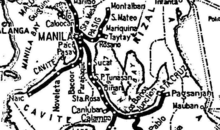
The Manila Railroad Company, which preceded PNR, operated various local trains between Manila and its neighboring provinces. Trains from Tutuban will lead to Naic in Cavite, Pagsanjan in Laguna, Montalban in Rizal, and Bulacan during the 1920s.[5]
The Manila Electric Railroad and Light Company (Meralco) also operated electrified Tranvia services in what is now Metro Manila.[6] The 100 km (62 mi) tram system reached Malabon to the north, Pasig to the east, and Libertad (now part of Pasay) to the south, making it one of the longest in Asia in 1924.[7] Both systems were heavily damaged during the Battle of Manila in World War II.[7]
PNR commuter services
Metro Manila Commuter Service (1970–89)
The Metro Manila Commuter Service started on April 6, 1970 which started at Manila North Harbor and ended in Biñan, Laguna. During this decade, more stations were opened although some were either closed or relocated. In 1976, the commuter system peaked and extended as far north as San Fernando, Pampanga,[8] Guadalupe (located in Mandaluyong on the other side of Pasig River) to the east, and College to the south.[9] There were also services in the now-defunct Carmona branch line.[10]
Metrotrak then Metrotren (1989–2009)
In 1990, the system was undergoing renovations under the working title Metrotrak.[3] By May of that year, the system was inaugurated as Metrotren to distinguish it from the LRT Line 1, then named "Metrorail".[4] However, the Metrotren system eventually suffered neglect due to lack of funding and maintenance. Plans for expansion and rehabilitation such as the Manila–Clark rapid railway project and Guadalupe line revival was also never realized.[11]
Post-Metrotren and Metro Commuter
The Arroyo administration attempted to modernize the PNR system by rebuilding the lines and purchasing new rolling stock. PNR purchased 6 brand new diesel multiple units from South Korea and became its first order in 35 years.[12] The government was also interested in reviving the Manila to Malolos NorthRail project. However, the line stopped construction in 2011 and only pillars were built.[13] The succeeding Aquino administration rebuilt the stations along the line to accommodate high-floor trains. PNR also acquired second-hand multiple units from Japan as stopgap measures to its train fleet, ending the Metrotren era.[14] However, services were further suspended to Santa Rosa in 2014,[15] and to Alabang in 2015 due to safety issues and accidents on the line.[16] The North Main Line has also been closed.[17]
The Duterte administration, Department of Transportation Secretary Arthur Tugade, and PNR General Manager Junn Magno, all promised to revive and modernize the PNR and its commuter line.[18] In 2017, the Department of Science and Technology announced its first Filipino-designed train and started trial services between Alabang and Calamba in 2018.[19]
For the present network, Magno announced the purchase of 3 diesel-hydraulic locomotives, 15 coaches, and 22 diesel-electric multiple units from Indonesian rolling stock manufacturer PT Industri Kereta Api or INKA. The INKA trainsets and 5 of the Hyundai Rotem DMUs will comprise a 14-train fleet that will replace the aging PNR 900 class as well as the second-hand rolling stock acquired by the Aquino administration, as these trainsets will be transferred to the Bicol Region for the Bicol Commuter services after 2020.[2] The present line will also be rebuilt during and after the construction of the North–South Commuter Railway as it will serve as an alternate transport mode to the NSCR.[20]
Route

The existing operational Metro Commuter Line is predominantly aligned and shares the path of the South Main Line or SouthRail which uses a dedicated right of way of its own. It terminates at Calamba Station despite having rails further towards Legazpi, Albay, but few trains stop at Sta. Rosa and Calamba Stations further to the south. Inter-provincial services such as the Bicol Express and Mayon Limited are not running as of 2015, but plans to revive the services have been presented.
- Legend
- Trains stop at stations marked "●".
- Trains pass those marked "|".
- Only morning and evening trains stop at stations marked "◇".
- Morning and evening trains stopping only on Sundays at stations marked "X".
- Evening southbound trains only load at stations marked "♦".
- Morning and evening trains only unload at stations marked "♠".
- For AA-LA-IRRI, some trains stop at stations marked ∆, while all trains stop at stations marked ✓
- closed stations
- MSC (TU-LA) — Metro South Commuter (Tutuban to Calamba)
- MSC (TU-IRRI) — Metro South Commuter (Tutuban to IRRI)
- MSC (AA-LA-IRRI) — Metro South Commuter (Alabang-Calamba- IRRI)
- MNC (TU-GP) — Metro North Commuter (Tutuban to Governor Pascual)
- MNC (GP-FTI) — Metro North Commuter (Governor Pascual to FTI)
- SS (TU-SU) — Shuttle Service (Tutuban to Sucat)
- SS (SA-SU) — Shuttle Service (Santa Mesa to Sucat)
- PT — Premiere Train
| Name | Distance (km) | Services | Transfers | Location | |||||||||
|---|---|---|---|---|---|---|---|---|---|---|---|---|---|
| Between stations | From Tutuban | From Governor Pascual | Metro Commuter | Shuttle | PT | ||||||||
| MSC (TU-LA) |
MSC (TU-IRRI) |
MSC (AA-LA-IRRI) |
MNC (TU-GP) |
MNC (GP-FTI) |
SS (TU-SU) |
SS (SA-SU) | |||||||
| Valenzuela | — | — | — | — | — | none | Valenzuela City | ||||||
| Governor Pascual | — | — | — | ● | ● | Malabon | |||||||
| Caloocan | — | — | — | ● | ● | Caloocan City | |||||||
| 10th Avenue | 1.460 | — | 1.460 | ● | ● | ||||||||
| 5th Avenue | 1.380 | — | 2.840 | ● | ● | ||||||||
| Solis | 1.460 | — | 4.300 | ● | ● | Manila | |||||||
| Tutuban | — | 0.000 | — | ● | X | ● | | | ● | ● | ||||
| Blumentritt | 2.730 | 2.730 | 5.530 | ● | ● | ● | ● | ||||||
| Laon Laan | 1.090 | 3.820 | — | ● | | | ● | | | none | |||||
| España | 0.700 | 4.520 | 7.320 | ● | ● | ● | ● | ||||||
| Santa Mesa | 1.970 | 6.490 | 9.290 | ● | ● | ● | ● | ● | |||||
| Pandacan | 1.470 | 7.960 | — | ● | | | ● | ● | | | none | ||||
| Paco | 1.500 | 9.460 | 12.200 | ● | ● | ● | ● | | | |||||
| San Andres | 0.960 | 10.420 | — | ● | | | ● | ● | | | |||||
| Vito Cruz | 0.600 | 11.020 | — | ● | | | ● | ● | | | |||||
| Buendia | 1.260 | 12.280 | — | ● | | | ● | ● | ● | Makati | ||||
| Dela Rosa | 0.120 | 12.400 | 15.320 | ● | ♦ | ● | | | | | | | ||||
| Pasay Road | 0.940 | 13.220 | — | ● | ♠ | | | ● | ● | ● | ||||
| EDSA | 1.080 | 14.300 | 17.150 | ● | ♠ | ● | ● | ● | ● | 3 MRT Line 3 Magallanes | |||
| Nichols | 3.600 | 17.900 | — | ● | ♠ | | | ● | ● | | | none | Taguig | ||
| FTI | 0.700 | 18.600 | 21.400 | ● | ♦ | ● | ● | ● | | | ||||
| Bicutan | 2.300 | 20.900 | — | ● | ♦ | ● | ● | | | Parañaque | ||||
| Sucat | 4.120 | 25.020 | — | ● | ♦ | ● | ● | ● | Muntinlupa | ||||
| Alabang | 3.673 | 28.693 | — | ● | ♦ | ∆ | ● | ||||||
| Muntinlupa | 3.320 | 32.013 | — | ◇ | ◇ | ∆ | | | ||||||
| Tunasan | — | — | — | — | | | | | |||||||
| San Pedro | 3.361 | 35.374 | — | ◇ | ◇ | ∆ | ● | San Pedro, Laguna | |||||
| Pacita Main Gate | 2.176 | 37.550 | — | ◇ | ◇ | ∆ | | | ||||||
| Golden City 1 | 1.170 | 38.720 | — | ◇ | ◇ | ∆ | | | Biñan, Laguna | |||||
| Biñan | 1.044 | 39.764 | — | ◇ | ◇ | ∆ | ● | ||||||
| Santa Rosa | 4.042 | 43.806 | — | ◇ | ◇ | ∆ | ● | Santa Rosa, Laguna | |||||
| Golden City 2 | 1.954 | 45.760 | — | | | | | | | |||||||
| Cabuyao | 1.660 | 47.420 | — | ◇ | ◇ | ∆ | | | Cabuyao, Laguna | |||||
| Mamatid | 5.530 | 52.950 | — | ◇ | ◇ | ∆ | ● | ||||||
| Banlic | 1.850 | 54.800 | — | | | | | | | |||||||
| Calamba | 1.338 | 56.138 | — | ◇ | ◇ | ✓ | Calamba, Laguna | ||||||
| Pansol | — | ◇ | ✓ | ||||||||||
| Masili | — | ◇ | ✓ | ||||||||||
| Los Baños | — | ◇ | ✓ | Los Baños, Laguna | |||||||||
| College | — | ◇ | ✓ | ||||||||||
| IRRI | — | ◇ | ✓ | ||||||||||
| Stations in italics are either under construction, not yet operational, or have been closed. | |||||||||||||
Rolling stock
The Metro Commuter Line has always used diesel-powered rolling stock since the services were opened in 1970. In 1976, PNR was able to expand its commuter and regional services when it bought 60 CMC railcars which remained in service until 2004.[21] These commuter trainsets however deteriorated in the 1990s and ordered second-hand 12 series coaches in their stead. The 12 series cars were hauled by PNR's diesel locomotives which were previously used in its intercity and freight services. There were no new orders until 2009 when PNR ordered the Hyundai Rotem DMUs, followed by second-hand multiple units and coaches from Japan.
PNR later ordered 7 new trains from Indonesian manufacturer PT INKA in 2018, subsequently increased to 9.[2] The DOST Hybrid Electric Train also entered trial service the same year.[19] The agency then commenced the refurbishment of its entire fleet the following year, which introduced polycarbonate windows that can resist stoning as well as a new livery. After all the INKA trainsets have arrived and the refurbishment of older trains are completed, the Hyundai Rotem DMUs and the INKA trainsets will become the Metro Commuter fleet while the older Japanese trainsets will be transferred to the Bicol Region for its new commuter service unless PNR decides otherwise.[2]
|
Locomotives:
|
Railroad cars:
|
Multiple units: |
Active rolling stock
| Locomotives | ||||||||
|---|---|---|---|---|---|---|---|---|
| Class | Image | Type | Top speed | Active units | Built | Gauge | Remarks | |
| mph | km/h | |||||||
| 900 | DEL | 64 | 103 | 9 | 1973–91 | 1,067 mm (3 ft 6 in) | Originally a class of 21 units, with 2 awaiting service.[22] | |
 |
DEL 917 adopted a new orange livery to follow suit with the upcoming CC300 locomotives.[22] | |||||||
| 2500 | _train_(Anonas_Street%2C_Santa_Mesa%2C_Manila)(2017-07-12)_2.jpg) |
DEL | 64 | 103 | 2 | 1965–79 | Originally a class of 43 locomotives. | |
| Coaches | ||||||||
|---|---|---|---|---|---|---|---|---|
| Class | Image | Type | Top speed | Active units | Built | Gauge | Remarks | |
| mph | km/h | |||||||
| 203 series | 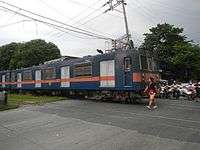 |
HEP | 60 | 100 | 29 | 1982–86 | 1,067 mm (3 ft 6 in) | Former JR East electric multiple units acquired in 2011 and replaced the 12 series coaches decommissioned in 2011.[22] Planned to be replaced by K3 coaches after 2020.[2] |
 |
C | |||||||
| Multiple Units | |||||||||
|---|---|---|---|---|---|---|---|---|---|
| Class | Image | Type | Top speed | Active units | Cars per set | Built | Gauge | Remarks | |
| mph | km/h | ||||||||
| KiHa 350 | _at_IRRI_flagstop%2C_Los_Ba%C3%B1os%2C_Laguna.jpg) |
DMU | 70 | 110 | 4 | 2–4 | 1967–68 | 1,067 mm (3 ft 6 in) | Former Kantō Railway rolling stock acquired in 2011.[22] Planned to be reassigned to Bicol Commuter after 2020.[2] |
| Kogane | 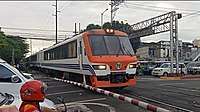 |
DMU | 70 | 110 | 3 | 3 | 1967–68; 1989 | Former JR East rolling stock acquired in 2012. Refurbished in 2019 and is planned to be reassigned to Bicol Commuter after 2020.[2] | |
| Hyundai Rotem | 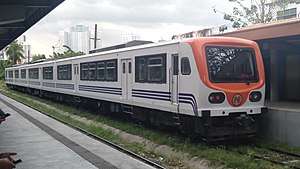 |
DMU | 50 | 80 | 12 | 3 | 2009 | Four units currently in service with one being refurbished as part of modernizing the Metro Commuter Line. | |
| HET | 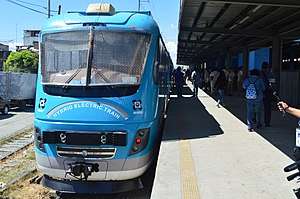 |
Hybrid DMU/BEMU | 50 | 80 | 5 | 5 | 2018 | In irregular service. | |
| 8000 | _and_TS-2(right)_parked_at_Tracks_5_and_4_respectively.jpg) |
DMU | 60 | 100 | 6 | 3 | 2018–19 | These units are equipped with the same horns used by older rolling stock, distinguishing it from the 8100 class. | |
| 8100 | 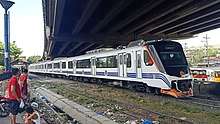 |
16 | 4 | 2019–20 | These were fitted with new higher-pitched horns compared to the 8000 class and the other rolling stock. | ||||
Future rolling stock
| Locomotives | ||||||||
|---|---|---|---|---|---|---|---|---|
| Class | Image | Type | Top speed | Units | Built | Gauge | Remarks | |
| mph | km/h | |||||||
| CC300 |  |
DHL | 75 | 120 | 3 | 2019–20 | 1,067 mm (3 ft 6 in) | Conjectural name based on the builder's number until the locomotive has been handed over to PNR. It is planned to replace the PNR 900 class after 2020. |
| Coaches | ||||||||
|---|---|---|---|---|---|---|---|---|
| Class | Image | Type | Top speed | Units | Built | Gauge | Remarks | |
| mph | km/h | |||||||
| K3 |  |
C | 75 | 120 | 15 | 2019–20 | 1,067 mm (3 ft 6 in) | Conjectural name based on the builder's number until handed over to PNR. Planned to replace the 203 series coaches after 2020. |
Former rolling stock
| Locomotives | ||||||||
|---|---|---|---|---|---|---|---|---|
| Class | Image | Type | Top speed | Units | Built | Gauge | Remarks | |
| mph | km/h | |||||||
| 5000 | DEL | 64 | 103 | 10 | 1960; 1992 | 1,067 mm (3 ft 6 in) | None of these units haul passenger trains as of 2020. One unit acts as a switcher transferring passenger cars in Manila, three more were transferred to Bicol Commuter services, and the remaining six are decommissioned.[22] | |
| Coaches | ||||||||
|---|---|---|---|---|---|---|---|---|
| Class | Image | Type | Top speed | Units | Built | Gauge | Remarks | |
| mph | km/h | |||||||
| 7A/12 (ja) |  |
C | 60 | 100 | 30 | 1970–77 | 1,067 mm (3 ft 6 in) | Acquired 1999 to replace some of the CMC fleet. Decommissioned by 2012 after the 203 series-derived coaches have replaced them. |
| Multiple Units | |||||||||
|---|---|---|---|---|---|---|---|---|---|
| Class | Image | Type | Top speed | Units | Cars per set | Built | Gauge | Remarks | |
| mph | km/h | ||||||||
| Nikkō | DMU | 26 | 2-3 | c. 1974 | 1,067 mm (3 ft 6 in) | Initially arranged in two-car trainsets, the class served commuter trains in the 1970s.[23] Transferred to Peñafrancia Express intercity services between Manila and Naga.[24] Has since been decommissioned in 2004.[22] | |||
| CMC | DMU | 59 | 95 | 60 | 2–10 | 1976 | Last units were retired in 2004 with some units transferred to PNR's maintenance equipment. Most of them have been scrapped in 2009.[22] | ||
| KiHa 52 | (2017-08-11)_1.jpg) |
DMU | 59[25] | 95[25] | 6 | 2–3 | 1963–66 | Transferred to Bicol Commuter services.[22] | |
Services
Current
Metro South Commuter
The Metro South Commuter (also known as MSC) is the main and only train service currently being offered by PNR that run along the Metro Commuter Line. The trains that are currently being used for this service are the 900 Series Locomotives, PNR 2500 Series Locomotives, 203 series ex-Joban Line Local EMUs donated by JR East, and the South Korean Hyundai Rotem DMUs. The trips are reduced upon announcements. On December 2, 2014, the new Calamba Station was inaugurated. Later that night, the MSC1907 was extended up to the said station. The MSC1937 was also extended, but only up to Sta. Rosa Station. As of July 2015, MSC services run between Tutuban and Alabang.[26] As of September 2019, the trips (morning and night) now reaches Calamba while the other service to Mamatid is dropped making the MSC1907 the only train servicing Laguna.
Governor Pascual-FTI service (Metro North Commuter)
On August 1, 2018, Philippine National Railways reinstated commuter train services to Caloocan station, as preparation for the Tutuban-Malolos railway, the first section of the railway line that will end at Clark in Pampanga. The line was reopened after the line was repaired due to water intrusion. According to claims by the Department of Transportation, it will be the most efficient way of travel between Caloocan and Makati. Services will continue operating until the completion of the Tutuban-Malolos Railway, after which the line will be mostly dedicated to cargo hauling.[27] Originally running from 10th Avenue to Dela Rosa, it was upgraded into the Caloocan-FTI shuttle service on September 10 (officially called the Sangangdaan-FTI shuttle service). On December 3, 2018, it was again extended to Acacia/Governor Pascual station, with plans to extend the service up to Valenzuela railway station, and poised to carry 120,000 passengers daily if completed.[20]
IRRI services (Metro South Commuter)
Tutuban/Dela Rosa-IRRI
On December 1, 2019, Train services to the International Rice Research Institute inside the campus of the University of the Philippines Los Baños were started. Five new stations were added to the route: Pansol and Masili in Calamba Laguna, and Los Baños, College and IRRI in the neighboring town of Los Baños.[28]
The service uses the Kogane train set previously used for Premiere Train Services. The service originates from Tutuban exclusively on Sundays, while it starts from Dela Rosa from Monday-Saturday. The train only loads a limited number of passengers in Dela Rosa, FTI, Bicutan, Sucat and Alabang Stations when going southbound, but unloading in stations in between like Nichols and EDSA are allowed.[29]
Alabang-Calamba-IRRI
On December 16, 2019, Regular Commuter services between Alabang, Calamba and IRRI were launched. The service uses Kiha-350 DMUs and runs the full route thrice daily from both endpoints and twice from the Calamba-IRRI segment.[30]
Past
Caloocan-Meycauayan Section
During the Metrotren era, Commuter Services was extended Northwards to Meycauayan, Bulacan on May 10, 1990, with the Caloocan to Meycauayan Extension of the services before it was abandoned in 1997 due to maintenance costs and inadequate services.
A part of this line was attempted to be revived, namely the stations up to Caloocan during the latter half of the 2000s, with the rest to be revived as part of the future Northrail. The DOTr reactivated the stations along Solis, 5th Avenue, 10th Avenue, Caloocan and Governor Pascual, which was disturbed due to the construction of NLEX Segment 10.1, for the Caloocan-Dela Rosa, Sangangdaan-FTI and Gov. Pascual-FTI shuttle as above-mentioned, and there are plans to rebuild the old lines to Valenzuela City and beyond to return full service revenue train stops to the CAMANAVA and potentially Bulacan area after many years.
Carmona Line
A spur line towards Carmona was opened on April 1, 1973 to serve the residents of the San Pedro-Carmona Resettlement Project, unfortunately, it fell into disuse, number of trips decreased and subsequently was abandoned. Plans are underway to renovate the line for a potential 2019 reopening, first for a 5th shuttle service and then towards a future return to revenue train services in the line.[31]
Shuttle Service
The Shuttle Service was introduced on January 27, 2014. This service uses Hyundai Rotem DMUs and JR KiHa 52. There are 4 routes of the Shuttle Service, where trains stop at all stations along the routes.
- Tutuban – Sucat
- Sucat – Tutuban
- Sta. Mesa – Sucat
- Sucat – Sta. Mesa
This train service was removed last May 23, 2014 to give way to maintenance servicing of the rolling stocks. Another reason was the 3 consecutive weeks of delays and cancellations of some train trips. The service officially returned to the line on August 1, 2018, this time, to serve from the 10th Avenue railway station up to the Dela Rosa railway station using a JR KiHa 350 DMU. An additional service, opening on September 10, operates from the reopened Caloocan railway station to the FTI railway station.
Premiere Train
The Premiere Train was a special MSC service that operates from Monday to Friday, except holidays. The train being used in this special service was the KiHa 59 "Kogane" train set, which is also from Japan. The train used to stop at selected stations only, namely Tutuban, Blumentritt, España, Sta. Mesa, Buendia, Pasay Road, EDSA (flagstop), Sucat, Alabang, San Pedro, Biñan, Santa Rosa, and Mamatid. The service had 4 trips: MSC501, MSC702, MSC1555, and MSC1802.
The service is currently suspended, due to the inauguration of the station building of Calamba (December 2014) and due to the repairs of the trainset being used for this service.
Expansion and reconstruction plans
North–South Commuter Railway
The North–South Commuter Railway will be a train line connecting the north and south boundaries of Mega Manila. Once fully operational by 2025, it will connect New Clark City in Capas, Tarlac to the north and Calamba, Laguna to the south.[32][33] The line will initially have 34 stations, expandable to 41 by 2030, and expand northward to Tarlac City and southward to Batangas City by 2040. The line will have commuter rail services as well as an airport limited express service connecting Clark International Airport with Alabang station.[34]
It will be a double-track line with direct current electrification through overhead lines. The line will also be built in the wider standard gauge compared to the 3 ft 6 in narrow gauge being used by PNR.[35] The NSCR North which will be between Tutuban and New Clark City will be fully elevated and will have both embankment and viaduct sections. while the NSCR South will feature a mix of elevated sections through viaducts, as well as an at-grade and underground section between EDSA and FTI stations. The maximum speed on the line will be up to 120 kilometers per hour (75 mph) for commuter trains and 160 kilometers per hour (99 mph) for the airport express trains.[34] The project costs ₱777.5 billion (US$ 15 billion) and is one of the flagship projects of the Build! Build! Build! Infrastructure Plan.
On July 2019, PNR ordered 104 Sustina Commuter cars from the Japan Transport Engineering Company (J-TREC) along with Sumitomo Corporation, which will be arranged into 8-car electric multiple units.[36] This is the first order out of 360 EMU cars with 304 cars allotted for commuter use and 56 cars for the airport express train.[37]
Metro North Commuter restoration
Metro North Commuter services have been restored in 2018, and there are plans to further extend the line north to Valenzuela station from its present terminus in Governor Pascual station in neighboring Malabon. A new bridge crossing the Tullahan River will also be built to connect the two stations. The expansion aims to reduce traffic congestion between Valenzuela and Makati. Although these services are planned to be superseded by the North–South Commuter Railway, the present line will continue serving passenger trains and will also serve freight trains in the future.[20]
Integration with intercity services
The intercity section of the South Main Line (tl) will be rebuilt under the PNR South Long Haul project. A new 639 km (397 mi) line will connect Metro Manila with the Bicol Region.[38] The entire section will also be built in standard gauge, similar to the NSCR but there will be no electrification. The line will also traverse the present Metro Commuter Line, initially from Calamba station by Phase 1, Sucat station by Phase 4, and eventually to Tutuban station.[39] Since the intercity services will traverse the narrow-gauge line, there will be a dual gauge network between these stations and IRRI station.
References
- Gonzales, Iris (December 22, 2018). "PNR: 'Rolling coffins' languish in snail-paced modernization". Philstar.
- Valdez, Denise (May 3, 2018). "PNR buys 7 new train sets from Indonesia". BusinessWorld. Retrieved July 21, 2020.
- "MetroTrak". Philippine Journal. Philippine News Agency. January 4, 1990. Retrieved July 22, 2020.
- "Metrotren inaugural". Manila Chronicle. May 11, 1990. Retrieved July 22, 2020.
- Orbon, Glenn; Dungca, Joana (2015). "The Philippine Railway System". Movement Systems.
- "100 Years with Meralco". meralco.com.ph. Meralco. October 11, 2004. Archived from the original on September 18, 2009. Retrieved May 28, 2020.
- Gamble, Adrian (March 10, 2017). "Manila's Long-Lost 'Tranvias' Once the Envy of Asia". skyrisecities.com. Skyrise Cities. Archived from the original on June 21, 2020. Retrieved June 21, 2020.
- "PNR Schedule effective September 11, 1976". www.flickr.com. Retrieved July 23, 2020.
- "Old PNR stations". Reddit. Retrieved July 23, 2020.
- "Carmona's Commuter Train". Times Journal. April 1973. Retrieved July 23, 2020.
- "Off track: Northrail timeline". ABS-CBN News. July 15, 2008. Retrieved July 23, 2020.
- "Ballast Train in Tayuman". May 25, 2009. Retrieved July 23, 2020.
- "Philippines: China-funded Northrail project derailed". Financial Times. Retrieved July 23, 2020.
- Montecillo, Paolo (September 26, 2011). "PNR gets old trains from Japan". Retrieved July 23, 2020.
- Macaraig, Ayee (May 6, 2014). "Senate panel: Extend PNR, improve services". Rappler. Retrieved July 23, 2020.
- Corrales, Nestor (July 23, 2015). "PNR resumes Tutuban-Alabang train operations". Philippine Daily Inquirer. Retrieved July 23, 2020.
- Camus, Miguel (July 16, 2015). "Gov't rolls out P171-B railway project". Philippine Daily Inquirer. Retrieved July 23, 2020.
- de Vera, Ben (April 10, 2017). "Infrastructure spending up 42.8% in 2016". Retrieved July 23, 2020.
- Uy, Jocelyn (July 20, 2016). "PNR tracks sought for test runs". Retrieved July 23, 2020.
- Parrocha, Azer (August 14, 2019). "Completed railway assets to ease traffic by 25%: DOTr". Philippine News Agency.
- "PNR Commuter Trains". Times Journal. October 29, 1976. Retrieved July 23, 2020.
- Peadon, Brad. "April 2020". Philippine National Railways Rolling Stock Update. Philippine Railways Historical Society. Vol. 3.
- "1974 1125 PNR Guadalupe Station". Flickr. November 21, 2011. Retrieved July 27, 2020.
- "1986 0210 PNR Nikko Train_Legazpi station". Flickr. August 12, 2016. Retrieved July 27, 2020.
- Okada, Seiichi (1996). "キハ20系車両のあゆみ(国鉄編)". Railway Pictorial (in Japanese). Electric Vehicle Study Group (Issue no. 605): pp. 10-17.CS1 maint: extra text (link)
- "PNR Official Site – Northbound & Southbound Timetable". Philippine National Railways. October 29, 2014. Retrieved September 5, 2016.
- "IN PHOTOS:After 20 years, PNR reopens Caloocan-Makati Line". The Philippine Star. August 1, 2018. Retrieved August 5, 2018.
- https://facebook.com/story.php?story_fbid=1564617300358612&id=134752476678442
- https://facebook.com/story.php?story_fbid=10159183855685299&id=605395298
- http://www.pnr.gov.ph/images/Timetable/alabang-irri.png
- https://www.facebook.com/DOTrPH/posts/1186365421502592
- Dela Paz, Chrissie (September 13, 2017). "NEDA Board approves Manila subway, longest railway". Rappler. Retrieved September 15, 2017.
- Leyco, Chino S. (September 13, 2017). "NEDA Board approves big infra projects". Manila Bulletin. Retrieved September 15, 2017.
- Department of Transportation The Republic of the Philippines (October 2018). "FEASIBILITY STUDY ON THE NORTH SOUTH RAILWAY PROJECT-SOUTH LINE (COMMUTER)(NORTH-SOUTH COMMUTER RAILWAY EXTENSION PROJECT) IN THE REPUBLIC OF THE PHILIPPINES" (PDF). jica.go.jp.
- "Philippines approves standard gauge for all new lines". www.railwaypro.com. August 10, 2016. Retrieved July 12, 2020.
- Lopez, Melissa Luz (July 16, 2019). "DOTr taps Japan bullet train supplier for Tutuban-Malolos railway". CNN Philippines. Retrieved July 18, 2019.
- Burroughs, David (October 17, 2019). "Five bids received for PNR Clark Phase 2 section of Manila of NSCR". International Rail Journal. Retrieved July 30, 2020.
- "Bicol Airport to open, PNR South on track". Manila Standard. January 7, 2020. Retrieved July 30, 2020.
- "South rail to start in Q2—Salceda". Manila Standard Business. November 21, 2019. Retrieved July 30, 2020.